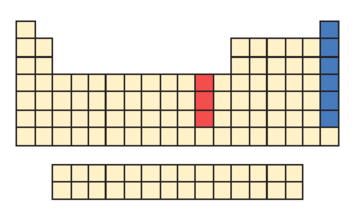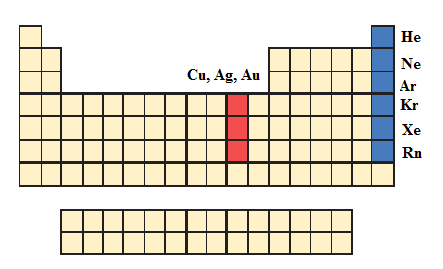
Concept explainers
The six elements in blue at the far right of the periodic table are gases at room temperature. The red elements in the middle of the table are the so-called coinage metals. Identify each of these elements using the periodic table inside the front cover of this book.

Interpretation:
The boxes that are highlighted red in colour has to be identified from the periodic table.
Concept Introduction:
Periodic table: It is arrangement of the chemical elements, ordered by their atomic number, electronic configuration and recurring chemical properties, whose structure shows periodic trends, than all elements present usually in rows, so that elements with similar atomic structure appear in vertical columns.
Answer to Problem 1.26UKC
The blue color indicated are Noble Gas family and the elements are Helium
Red color indicated in periodic table is the coinage metals namely, copper
Explanation of Solution
Let us consider the given statement of periodic table.

Above periodic table, and corresponding blue color indicated by Noble gas elements like Helium
Red color indicated in the periodic table is the coinage metals namely, copper
The elements were identified given the periodic table with respective colors.
Want to see more full solutions like this?
Chapter 1 Solutions
Pearson eText Fundamentals of General, Organic, and Biological Chemistry -- Instant Access (Pearson+)
Additional Science Textbook Solutions
Chemistry: Structure and Properties (2nd Edition)
Introductory Chemistry (6th Edition)
Campbell Essential Biology (7th Edition)
Campbell Biology (11th Edition)
Human Biology: Concepts and Current Issues (8th Edition)
Cosmic Perspective Fundamentals
- Pls helparrow_forwardH₂N NH peptide_0e60 A dipeptide is made up of two (2) amino acids. The figure above shows one such dipeptide with an unknown sequence. Your task is to find out the two (2) letter sequence of this dipeptide.arrow_forwardcarbons in each of the structures below. For instance, the central carbon of chloromethylbutane (pictured 3. A chiral carbon is a carbon that is single-bonded to four different types of groups. Identify the chiral above) is a chiral carbon. (Can you see how the groups attached to it are all chemically different?) In each of the chiral molecules below, identify all the carbons that are chiral carbons by drawing a circle around each one of them. (a) the carbohydrate glucose H O (b) the carbohydrate fructose CH₂OH 1C H-C-OH 3 HO-C-H 4 H-C-OH 5 H-C-OH 6CH₂OH D-Glucose (linear form) (c) the amino acid leucine O O H3C. HO H H- -OH CH 3 NH2 H- -OH CH₂OH OHarrow_forward
- We always include controls in the Annexin-V-GFP/Propidium Iodide flow cytometric assay to study apoptosis. List four types of controls in this assay. Why do we need these controls? Explain your answers. After the flow assay, if we like to examine the morphology of the viable, early apoptotic and late apoptotic cells by confocal microscopy, what can we do and what are the expected results?arrow_forward3. (2 points) Your lab partner accidentally used a pen instead of a pencil to mark the baseline and label the lanes of their TLC plate. Briefly (1-2 sentences for each point) describe (a) what would happen to the ink when you develop the TLC plate; and (b) how this would affect the experiment. 1arrow_forwardCan you help me with question 4arrow_forward
- Determine Km and Vmax from the michaelis menten grapharrow_forwardDetermine the Km and Vmax from the lineweuver burk grapharrow_forwardDo schwann cells produce or act as myelin in the peripheral nervous system? I know that they encase and wrap around axons, but where does the myelin come into play?arrow_forward
- The enzyme lactate dehydrogenase (LDH) catalyzes the conversion of pyruvate to lactatein skeletal muscle cells using NAD/NADH during anaerobic “balanced” fermentation.Answer the following questions about this reaction. (a) Write out the two reductive half reactions and indicate the E ̊' for each half reaction. Write out the full balanced reaction for the pyruvate to lactate rxn and indicate the ∆E ̊' for the reaction. (b) What is the free energy change under standard state conditions for thisreaction? Which direction is spontaneous?(c) Assume that in skeletal muscle cells the ratio of [NAD+] to [NADH] is 100, and that the[pyruvate] = 0.40 mM and [lactate] = 4.0 mM. What is the free energy change (∆G')for the conversion of pyruvate to lactate? Indicate the direction in which the reactionis spontaneous under these cellular conditions.arrow_forwardWhy did the authors worry about the temperature-dependent solubility of the carriers in thebilayer? How did the authors determine whether the effect of freezing the lipid bilayer wasto decrease the solubility of the carriers (nonactin and valinomycin) or whether the effectwas to impair their ability to diffuse through the membrane (decrease their mobility)?arrow_forwardKranse et. al. measured the temperature dependence of conductance using membranescontaining the phospholipids glyceryl dipalmitate and glyceryl distearate. Describe themodifications in membrane content that you would employ to: (a) shift the temperature of the phase transition (b) make the ion conductance curve for valinomycin andnonactin more like that of gramicidinarrow_forward

 Principles Of Radiographic Imaging: An Art And A ...Health & NutritionISBN:9781337711067Author:Richard R. Carlton, Arlene M. Adler, Vesna BalacPublisher:Cengage Learning
Principles Of Radiographic Imaging: An Art And A ...Health & NutritionISBN:9781337711067Author:Richard R. Carlton, Arlene M. Adler, Vesna BalacPublisher:Cengage Learning





